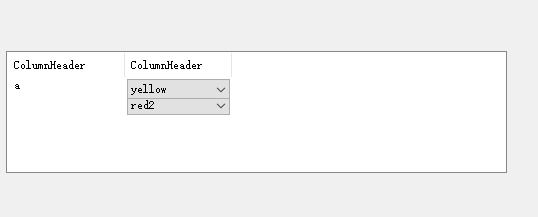Winform ListView中使用combox填充单元格

1 2 3 4 5 6 7 8 9 10 11 12 13 14 15 16 17 18 19 20 21 22 23 24 25 26 27 28 29 30 31 32 33 34 35 36 37 38 39 40 41 42 43 44 45 46 47 48 49 50 51 52 53 54 55 56 57 58 59 60 61 62 63 64 65 66 67 68 69 70 71 72 73 74 75 76 77 78 79 80 81 82 83 84 85 86 87 88 89 90 91 92 93 94 95 96 97 98 99 100 101 102 103 104 105 106 107 108 109 110 111 112 113 114 115 116 117 118 119 120 121 122 123 124 125 126 127 128 129 130 131 132 133 134 135 136 137 138 139 | using System;using System.Collections.Generic;using System.ComponentModel;using System.Data;using System.Drawing;using System.Linq;using System.Text;using System.Threading.Tasks;using System.Windows.Forms;namespace WindowsFormsAppTest{ public partial class ListViewxc : ListView { private List<Control> controlsxc = new List<Control>(); private const int WM_PAINT = 0x000F; public ListViewxc() { InitializeComponent(); controlsxc.Clear(); this.OwnerDraw = true; this.DrawColumnHeader += new DrawListViewColumnHeaderEventHandler(this_DrawColumnHeader); this.DrawSubItem += new DrawListViewSubItemEventHandler(this_DrawSubItem); } protected override void OnPaint(PaintEventArgs e) { foreach (Control item in controlsxc) { ListViewSubItemxc subItemxc = item.Tag as ListViewSubItemxc; if (subItemxc != null) { Rectangle r = subItemxc.Bounds; ComboBox combox = item as ComboBox; if (combox != null) { if (r.Y > 0 && r.Y < this.ClientRectangle.Height) { combox.Visible = true; combox.Bounds = new Rectangle(r.X + 2, r.Y + 2, r.Width - (2 * 2), r.Height - (2 * 2)); System.Diagnostics.Debug.WriteLine(",,," + r.X + " " + r.Y + " " + r.Width + " " + r.Height); } else { combox.Visible = false; } } } } base.OnPaint(e); } protected override void WndProc(ref Message m) { if (m.Msg == WM_PAINT) { foreach (Control item in controlsxc) { ListViewSubItemxc subItemxc = item.Tag as ListViewSubItemxc; if (subItemxc != null) { Rectangle r = subItemxc.Bounds; ComboBox combox = item as ComboBox; if (combox != null) { if (r.Y > 0 && r.Y < this.ClientRectangle.Height) { combox.Visible = true; combox.Bounds = new Rectangle(r.X + 2, r.Y + 2, r.Width - (2 * 2), r.Height - (2 * 2)); System.Diagnostics.Debug.WriteLine(",,," + r.X + " " + r.Y + " " + r.Width + " " + r.Height); } else { combox.Visible = false; } } } } } base.WndProc(ref m); } private void this_DrawSubItem(object sender, DrawListViewSubItemEventArgs e) { e.DrawDefault = true; } private void this_DrawColumnHeader(object sender, DrawListViewColumnHeaderEventArgs e) { e.DrawDefault = true; } public void AddItemxc(ListViewItem item) { foreach (ListViewItem.ListViewSubItem it in item.SubItems) { ListViewSubItemxc x = it as ListViewSubItemxc; if (x != null && x._control != null) { this.Controls.Add(x._control); x._control.Tag = x; ComboBox co = x._control as ComboBox; if (co != null) { co.SelectedIndexChanged += Co_SelectedIndexChanged; controlsxc.Add(co); } } } this.Items.Add(item); } private void Co_SelectedIndexChanged(object sender, EventArgs e) { ComboBox co = sender as ComboBox; ListViewSubItemxc x = co.Tag as ListViewSubItemxc; if (x != null) { x.Text = co.SelectedText; } } } public class ListViewSubItemxc : ListViewItem.ListViewSubItem { public Control _control = null; public ListViewSubItemxc(Control con) { _control = con; } }} |
1 2 3 4 5 6 7 8 9 10 11 12 13 14 15 16 17 18 19 20 21 22 23 24 25 26 27 28 29 30 31 32 33 34 35 36 37 38 39 40 41 42 43 44 45 46 | using System;using System.Collections.Generic;using System.ComponentModel;using System.Data;using System.Drawing;using System.Linq;using System.Text;using System.Threading.Tasks;using System.Windows.Forms;namespace WindowsFormsAppTest{ public partial class Form1 : Form { public Form1() { InitializeComponent(); } private void Form1_Load(object sender, EventArgs e) { ListViewItem l = new ListViewItem(); l.Text = "a"; ComboBox cb = new ComboBox(); cb.DropDownStyle = ComboBoxStyle.DropDownList; cb.Items.Add("yellow"); cb.Items.Add("red"); cb.SelectedIndex = 0; ListViewSubItemxc lxc = new ListViewSubItemxc(cb); ListViewItem l2 = new ListViewItem(); ComboBox cb2 = new ComboBox(); cb2.DropDownStyle = ComboBoxStyle.DropDownList; cb2.Items.Add("yellow2"); cb2.Items.Add("red2"); cb2.SelectedIndex = 1; ListViewSubItemxc lxc2 = new ListViewSubItemxc(cb2); l.SubItems.Add(lxc); l2.SubItems.Add(lxc2); listViewxc1.AddItemxc(l); listViewxc1.AddItemxc(l2); } }} |





【推荐】国内首个AI IDE,深度理解中文开发场景,立即下载体验Trae
【推荐】编程新体验,更懂你的AI,立即体验豆包MarsCode编程助手
【推荐】抖音旗下AI助手豆包,你的智能百科全书,全免费不限次数
【推荐】轻量又高性能的 SSH 工具 IShell:AI 加持,快人一步
· 阿里最新开源QwQ-32B,效果媲美deepseek-r1满血版,部署成本又又又降低了!
· 开源Multi-agent AI智能体框架aevatar.ai,欢迎大家贡献代码
· Manus重磅发布:全球首款通用AI代理技术深度解析与实战指南
· 被坑几百块钱后,我竟然真的恢复了删除的微信聊天记录!
· AI技术革命,工作效率10个最佳AI工具
2018-06-02 Qt Creator快捷键设置